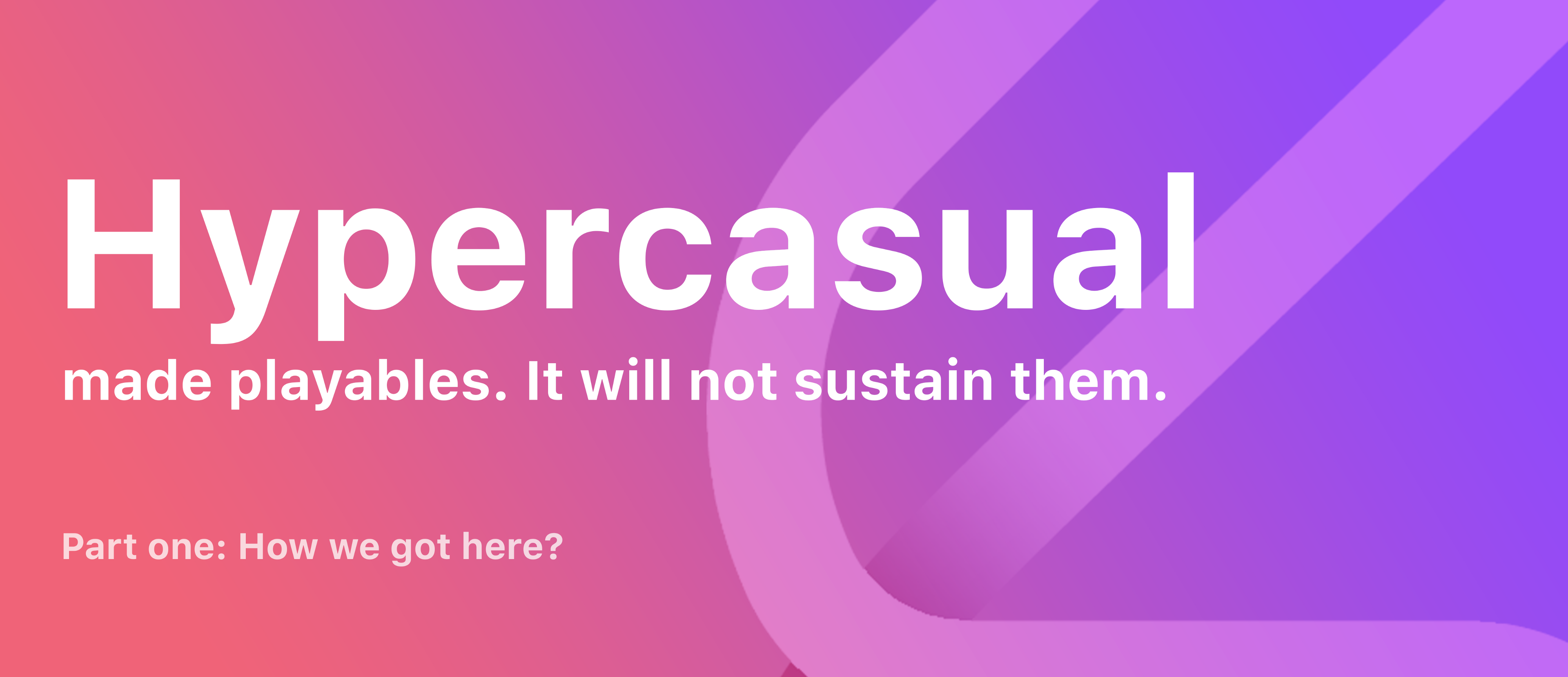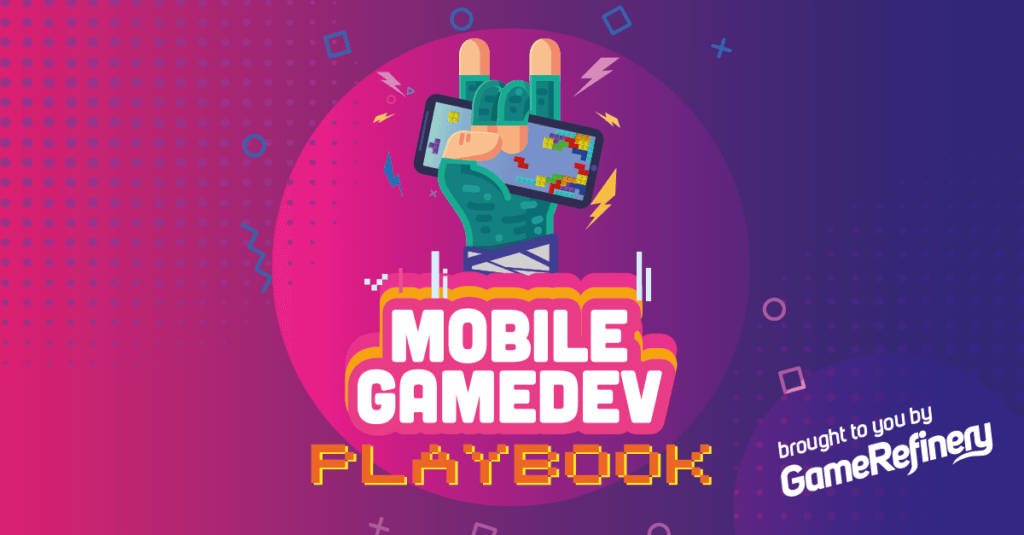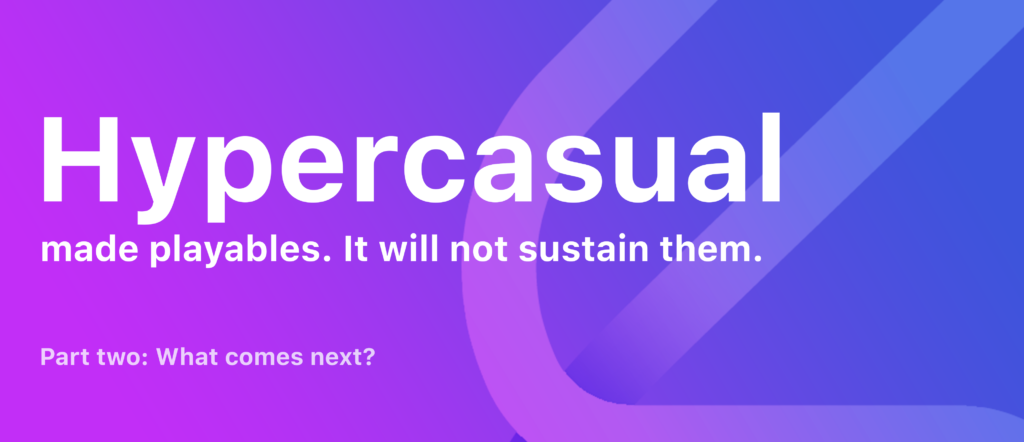In 2019, playable ads rose to the forefront of mobile advertising as a top-performing creative format*. Today, nearly every mobile gaming studio is looking to untap the creative potential they can bring.
Editors Note: This article was originally published by Adam Stevens, Chief Product Officer at Luna Labs. You can read the original version here.
At Luna, we experience this in every conversation we have with our partners, and in the results we see together. Playable ads have become an integral part of any attempt to scale a game with a healthy margin. Finding shareable data on the extent to which playables have contributed to the success of today’s top games is difficult, as studios tend to keep such information close to their chest. However, we can say with certainty that when you find the right game and the right playable ad flow, this creative can dominate the ad spend across channels and drive unparalleled scale.
Leading the playable ads movement over the past 2 years were hypercasual game studios. We want to take a look at how hypercasual created the perfect storm which propelled playable ads into primetime, and why they chose to address some of the biggest problems with the format in order to get us here.
In part two, we’ll look at the future potential for the format. Despite the impact they’ve had for these studios, we predict that in 2020, hypercasual will not be able to sustain its growth. We will see some of the current trends disappear, with new trends quickly replacing them. New genres, sub-genres and even verticals will start to play their part in the format’s journey, but as we’ll see, they must first find the answer to some unknowns, in order to do so.
Playable ads are not a new concept…
Ad networks have supported some form of an interactive format for many years. Looking at the most recent trend, you can easily find articles like this one from Gamasutra claiming interactive ads were the future from as early as July ‘16.
More specifically, early success stories like Game of War (Machine Zone) in 2016 show us that playable ads have not only ‘been around’, but used to drive significant scale.
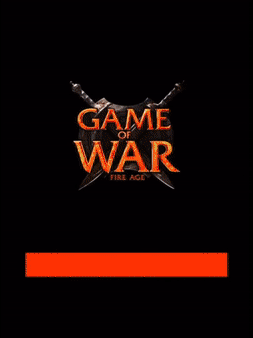
The ads were simple, lightweight and nothing like the game — but indeed playable. They were able to create exciting levels of engagement for a relatively low creative cost (thanks to their simplicity these ads were quick to create).
So what took so long? Why didn’t playables hit the mainstream earlier?
Isolated use cases were not enough of an incentive for studios to invest in the format, because there still remained three core areas of uncertainty:
- Knowledge: the what?
What makes a good playable? - Technology: the how?
How do I create a playable ad? - Success Stories: the why?
I need to see repeated success in order to invest resources.
With these unanswered questions limiting the growth of the format, there needed to be a group of pioneers to take a risk and answer them — clearly there was potential here, but it was yet to be understood.
Hypercasual were those pioneers, but in taking such a risk and investment of resources to explore, there needed to be a big enough incentive for success… and there certainly was.
Creating the need
Hypercasual games are a commodity in an extremely time-sensitive environment — the market moves fast, trends evolve and competition is fierce. Just take a look a the current top games on iOS…. the majority are hypercasual, from 12 unique publishers.
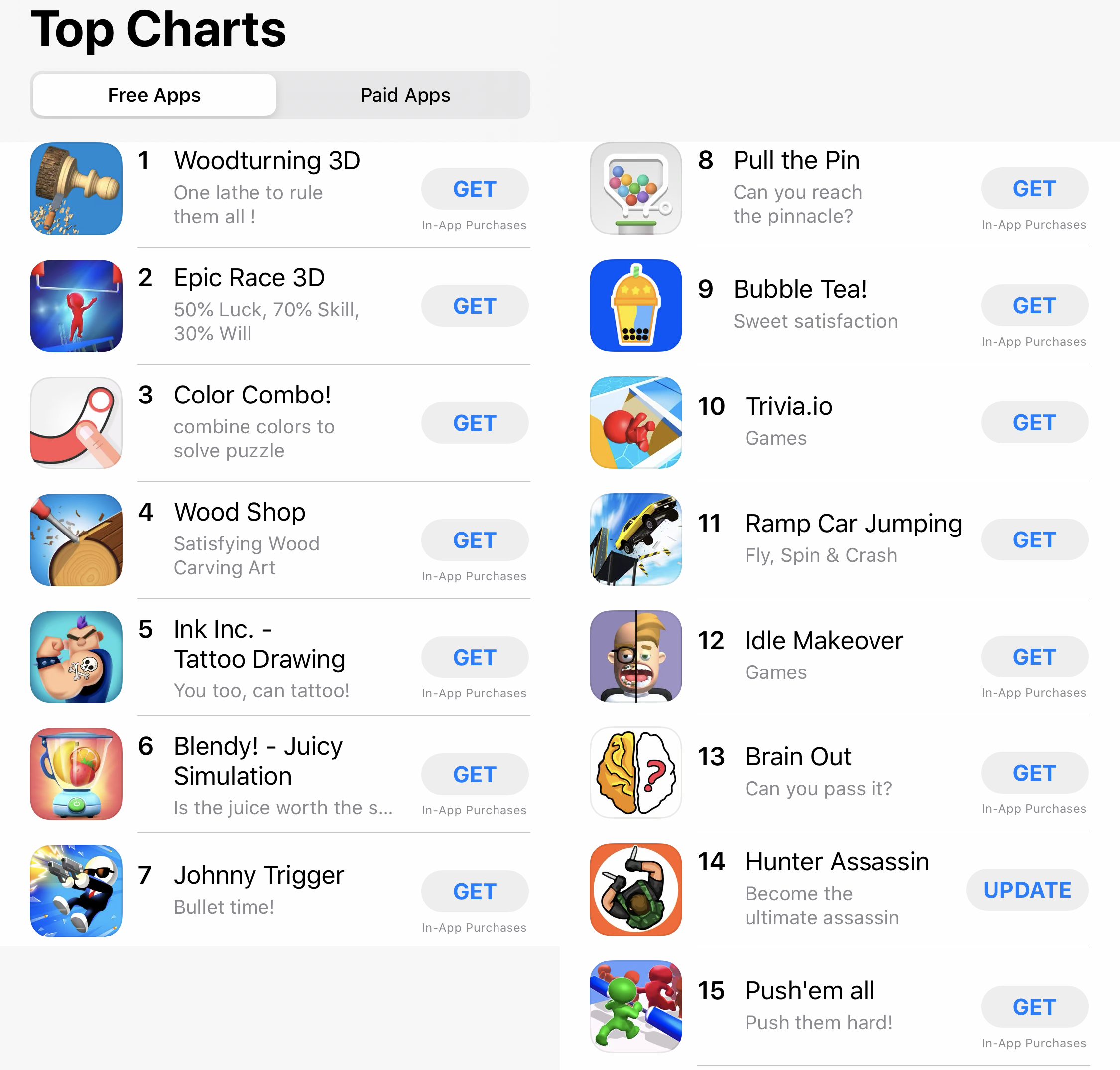
So why the competition? What changed to flood the market with so many studios, all able to reproduce such success?
Well, let’s take a step back. In the early days, hypercasual growth came from organic installs and cross-promotion (think of Ketchapp for example). But as hypercasual evolved, these companies became smarter at monetisation (efficient waterfalls, use of video interstitials and rewarded video), and the ARPDAU increased to a point that paid UA could now be ROI positive. And with this, unseen scale could be reached.
So whilst the games themselves proved attractive — short dev cycle, linear mechanics, simple graphics — it was the business model which had the highest appeal to newcomers.
If you could find a game which hit your target KPIs from the seemingly endless supply pool, then studios could execute the model; one focused on scale — how big can you grow, and margin — how cheaply can you do it.
Scale
For hypercasual, everyone is a potential player given the easy, addictive and non-committal style of gameplay. As such, user quality (targeting) isn’t a primary consideration — every download counts.
Margin
Revenue is generated from in-app advertising, and the monetisation model is predictable — LTV is a product of # ads per user per day, eCPM and retention. And if this exceeds the CPI, thumbs up.
Margins are typically optimised for in the soft-launch or testing phase, where the focus is on driving up retention and driving down CPI. Assuming the game has legs and the studio does its job, the rest is in the marketing, where the tactic is aimed at scale, and this means optimising for IPM (installs per thousand impressions i.e. the most important metric >> read this).

IPM is the metric to move, but we must look to the contributing factors to get there… and IPM is proportional to CTR — that’s more tangible. So as long as you can increase CTR without massively degrading Install Rate (this is a problem we’ll talk more about in part two), the path forward for UA growth is quite clear —get as much exposure for your ads, and drive as many users to the app store as you can.
With this in mind, what did playables offer hypercasual studios that other formats couldn’t? Why take the risk and deviate from the established creative channels? Could they generate a different type of user intent that allowed you to push meaningful CTR?
Traditionally, videos have been the most performant format for any genre due to their ability to draw in audiences and leave them wanting to try the game. Even today, videos are often the most important format for hypercasual, driving significant performance. But with the aim of increasing this scale, and finding new edges, they looked for more…
Even though ROI positive UA was now possible, it wasn’t a slam dunk. The studios needed to find new creative ways to unlock competitive IPMs and increase their reach on the ad networks.
And so, some of the early studios looked to playables. Unlike video, playables offered a set of tangible steps to increase CTR for a given ad opportunity—
1. Get the user to play the ad (engage them).
2. Convert that interaction into a click.
Hypercasual studios are very good at optimising towards a goal… and so these were simply two more, very reasonable goals, which studios believed you could optimise for through testing and know-how.
Armed with this hypothesis and early tests proving that value existed, hypercausal had something which could potentially unlock new performance. Now, they needed to answer two important questions in order to turn this new creative type into a feasible strategy for the scale they needed.
1. The “perfect” gameplay for advertising — solving the “what”
Hypercasual games are…
- Easy to pickup and play — simple onboarding
- Made up of repeatable design patterns and mechanics — simple to master
- Create a quick sense of achievement — simply satisfying
The first point here is that hypercasual games can be picked up by anyone, understood and played in under 10 seconds. The onboarding experience is almost none existent because the pure simplicity of the game speaks for itself.
Here’s an example of level one of a game by Alictus.
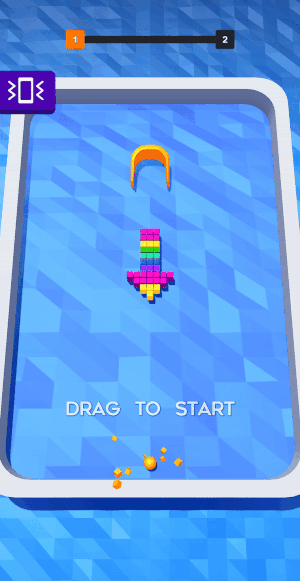
The tutorial includes three words (“Drag to start”) and a down arrow… That’s it. That’s all the user needs to understand what to do, and is very typical for all hypercasual.
These short and simple tutorials turned out to be perfect for playables. Ads which start by immediately asking the user to interact is a mechanism which creates high engagement — if you don’t interact, you’ll never know what is on offer.
Secondly, these games almost all have a single mechanic and linear progression, either with an expanding level or multiple short levels following a repeating pattern (check out Jetpack Jump and Shootout 3D by Kwalee for respective examples). In fact, the games often don’t get more difficult with time, but the user unlocks new items (visuals, styles, scenery, skins etc) or skills which provide a sense of progression. And with this mechanic, the formula is simple. Users can win and advance, or lose and try again. Both create a psychological relationship that leaves them wanting more.
So our first question was answered for hypercasual… the short, satisfying and easily understandable levels lent themselves perfectly for playable gameplay. Why not simply show your audience the very tutorial or level that work so well in getting them into the game in the first place?
And while this approach led to an ad flow which pulled in users, we’ve seen over 2019 that these short-form playables also expose the ability to drive significant traffic for hypercasual, optimising of course for CTR.
Among others, one of the most popular approaches is the “Play next level” ad flow. You allow the user to play a snippet of the game and tease the ability to replay or progress further. The user agrees they want to continue playing, but ends up in the store. And, oh well, why not just download the game while you’re there.
2. Simplistic games don’t need advanced technology — solving the “how”
The main constraint for playable ads is the format in which they must be created: HTML. This presented a problem for the majority of game developers. Most of their games are built in Unity which doesn’t support this format with a file size or startup time acceptable for the ads ecosystem (everything must be very small and very quick to load).
Whilst Luna is solving this problem today (see more about the move to in-house technology in part two as a way to sustain the playable ecosystem), in 2018, hypercasual studios were looking for solutions which had to be quick and simple to learn given the typical lack of HTML developers within the studios. Initially, the first movers started to get around this by creating similar-looking versions of the games internally using tools like Phaser or Three.js — these were quick and simple approximations of the game, but enough to test the hypotheses.
Even though necessary, this approach was flawed from the outset — studios mosty lacked in house talent (they may have had a single developer who happened to know how to build basic demos in HTML) but they definitely lacked the time — launching so many games on a monthly basis meant they needed handfuls of playables, and this approach quickly became a bottleneck (ads could take 2 weeks to build and performance wasn’t guaranteed).
At around the same time, and in recognition of this need, ad networks also began to develop their own solution. Seeing this pain point but untapped potential, they started offering creative services as part of their platforms. By centralising a team of talented developers, they could serve multiple studios and learn from the results. And of course, better performance == more spend on the ad network. It was win-win.

But in 2019, as the demand for playables only grew, even the ad networks became overwhelmed. Again wait times began to reach the 2–3 week mark.
In reaction to this increasing pressure, and a key moment in the history of the format was the creation and rise of outsourcing studios who were (like the ad networks) positioned to solve the two biggest problems — talent and technical expertise. They started to pick up the overflow and found their own unique value propositions as they grew. They could also offer multiple network compatibility, which was an important selling point.
3. Playables now have their success story — so now what?
And so finally, with the two main questions answered, hypercasual playables exploded. Every chart hitter used playables. IPM trends rose steeply. More studios flooded into the market and the tactics for driving performance evolved and became commonplace.
The pioneers had taken a risk, and made it through the other side. And in doing so, created a case study for the rest of the industry. In 2019, we saw other genres begin to look at playables for growth.
But where hypercasual studios moved fast thanks to their need for growth and above all else, simplicity in design and business model, more casual or mid-core studios cannot act under the same framework.
These games don’t enjoy some of the luxuries of hypercasual which allowed playable ads to follow a formula. Their user targetting is narrower. Their game loops are longer and more complex to understand, and inherently harder to convey in a short playable experience. And above all, the need for an install is superseded by their need for a quality install which will create long-term value.
These studios have found the why, but now face the challenge of finding their own what and how.

